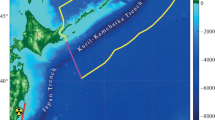A method is proposed for analyzing and evaluating the dynamics of self-decontamination of the region of the Fukushima-1 NPP contaminated by radioactive substances. The activity flux into the sea and average self-decontamination time of the territory due to decay and wash-off of the radionuclides 137Cs and 134Cs in the region of the NPP are obtained. The wash-off time constant of 137Cs for the contaminated territory is determined from the experimental data. It is significantly greater than for the basins of the other rivers studied. This is due to the hydrological particularities of the rivers in Japan. It is shown that the maximum dose rate in the region of contamination will decrease to the background level in approximately 200 years. It is determined that the 137Cs concentration in suspension does not depend on the water flow rate in the river; the 137Cs flux is proportional to this flow rate, including in floods.
Similar content being viewed by others
References
Results of the Research on Distribution of Radioactive Substances Discharged by the Accident at TEPCO’s Fukushima Dai-ichi NPP: Summarized Version, Emergency Operation Center, Ministry of Education, Culture, Sports, Science and Technology, Agriculture, Forestry and Fisheries Research Council, Ministry of Agriculture, Forestry and Fisheries, April 2012.
M. Ebihara, N. Yosida, and Y. Takahashi, “Preface: migration of radionuclide from the Fukushima Daiichi nuclear power plant accident,” Geochem. J., 46, 267–270 (2012).
I. I. Andreev, A. I. Laikin, and Yu. A. Platovskikh, “Analysis of the wash-off of radionuclides from the areas of river basins,” At. Énerg., 110, No. 3, 163–169 (2011).
M. A. Kabir, D. Dutta, and S. Hironaka, “Process-based distributed modeling approach for analysis of sediment dynamics in a river basin,” Hydrol. Earth Syst. Sci., 15, 1307–1321 (2011).
K. K. Edelshtein, Hydrology of Continents, IPK Akademiya, Moscow (2005).
Yu. G. Mokrov, Reconstruction and Prediction of the Radioactive Contamination of the Techa River: Dissert. Doct. Techn. Sci., PO Mayak, Ozersk (2005).
Yu. A. Platovskikh, I. V. Sergeev, Yu. V. Kuznetsov, et al., “Mathematical modeling and analysis of the behavior of radionuclides in the system Krasnoyarsk Mining and Chemical Works–Enisei–Kara Sea,” At. Énerg., 95, No. 6, 457–466 (2003).
Yu. A. Izrael (ed.), Chernobyl: Radioactive Contamination of the Environment, Gidroatomizdat, Leningrad (1990).
J. M. Martin and A. J. Thomas, “Artificial radionuclides discharged by the Rhone river,” J. Envir. Radioact., 11, No. 2, 105–139 (1990).
Ts. E. Mirpukhulava, Fundamentals of the Physics and Mechanics of the Erosion of River Beds, Gidrometeoizdat, Leningrad (1988).
Author information
Authors and Affiliations
Additional information
Translated from Atomnaya Énergiya, Vol. 117, No. 2, pp. 103–109, August, 2014.
Rights and permissions
About this article
Cite this article
Kuchin, N.L., Laikin, A.I. & Platovskikh, Y.A. Prediction of Self-Decontamination of Contaminated Territory Near the Fukushima-1 NPP (Japan). At Energy 117, 130–137 (2014). https://doi.org/10.1007/s10512-014-9900-6
Received:
Published:
Issue Date:
DOI: https://doi.org/10.1007/s10512-014-9900-6




